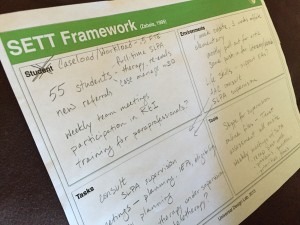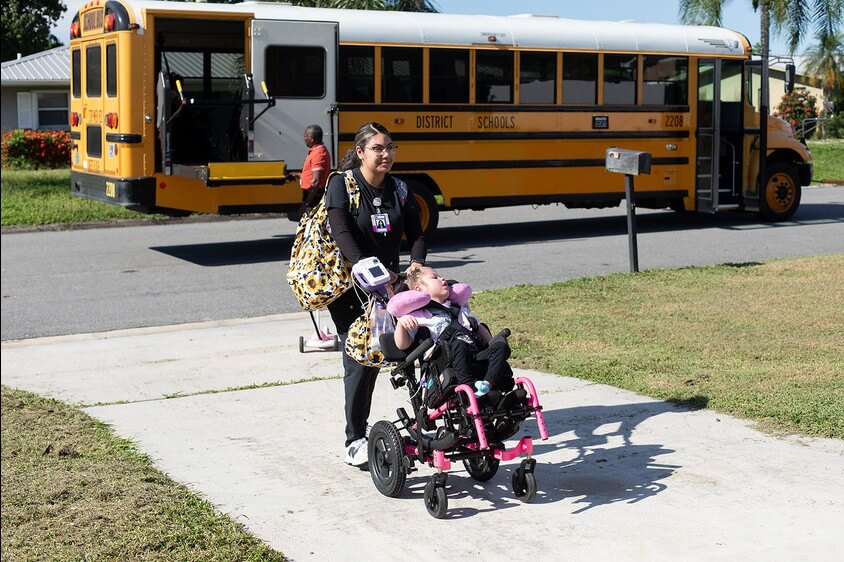You know how sometimes the simplest tools are the most powerful?
I see it all the time in my work with kids. A whiteboard. A hand-written checklist. A picture taped to the corner of the desk. I certainly believe in (and frequently witness) the wonders of ‘high-tech’ solutions, but the simplest ones – often simple to design, make, and implement – seem easiest to overlook.
Easy to overlook, especially at a busy time like back-to-school – our minds spinning with possibilities, fresh from the summer break. It’s at this time of year that I may be most likely to think big, complex, and high-tech. Maybe that’s why, at a Back To School AT/AAC Prep session, put on by the PSU Universal Design Lab and Dr. Samuel Sennott, the SETT framework caught my attention.
What is the SETT Framework?
SETT is an acronym for Student, Environment, Tasks, and Tools, and is used to describe a 4-part model for collaborative decision-making in all phases of assistive technology service design and delivery. This framework supports teams in making plans, identifying resources, and setting priorities and is frequently used when choosing an AT/AAC device or approach. Most recently, in my personal experience with SETT, I was part of a team that chose an AAC approach for a non-verbal kindergartner last winter. This student is still on my caseload, and it struck me this fall that the first grade is a different environment from her kindergarten classroom, with potentially different tasks demanded of her. Though the device we chose last winter may still be appropriate, a team meeting, I thought, could help us make sure we were still using the most well-suited tools.
Then something happened.
Some sort of SETT epiphany! It was like I had been working in a dark room with a spotlight on that one student… and someone turned the lights on. At that moment, I saw lots of other ways I could harness this simple and powerful framework, choosing the right tool for whatever job was at hand: * my teletherapy work, * our company’s efforts to create community, * a colleague managing an unexpected workload.
When looking for solutions to complex issues, it only makes sense to consider the environment, the tasks, and the tools available. The SETT matrix provides a space to consider each of these. In the upper left quadrant of the matrix, I could effectively substitute “caseload”, “company”, or “district” for the area traditionally labeled “student”.
Note: Joy Zabala has many forms and scaffolds available on her website for various uses.
The SETT framework is designed to help a team with different perspectives consider all the available information before making any decisions. This is essential in a process of problem-solving, especially when problems are complex. Whether trying to manage workload for yourself or come up with a new therapy idea after your first five haven’t worked, it is only with a full picture of the demands, environments, and expectations that make up the issue, that you can really address the barriers – real or assumed – to finding a creative, efficient, and workable solution.
My challenge to myself this fall, and to anyone facing complex problems involving multiple stakeholders, is to approach these big issues from a SETT perspective. To sit down in front of a blank matrix, and use the SETT framework to create an atmosphere of “active, nonjudgmental sharing”. It would be great to have a collaborative team, but even if you’re asking a co-worker or colleague to help you think about your personal workload, start by sharing – actively and nonjudgmentally! – all the information you have. * Do you have a complete picture of the issue? * Are there ‘unknowns’ you still need to research? * Who are the parties that will be affected by your solution, and what are their priorities? Then, just as the SETT moves us forward, consider the barriers keeping these needs from being met, and the inevitably wide variety of tools available to address those needs.
Just see if the nonjudgmental and open framework of a blank (and maybe slightly modified to meet your needs?) SETT matrix can help you or your team to approach complex issues in a creative way. It might just be the simple, powerful, but overlooked tool, right in front of us. A new lens through which we can examine our toughest challenges.






